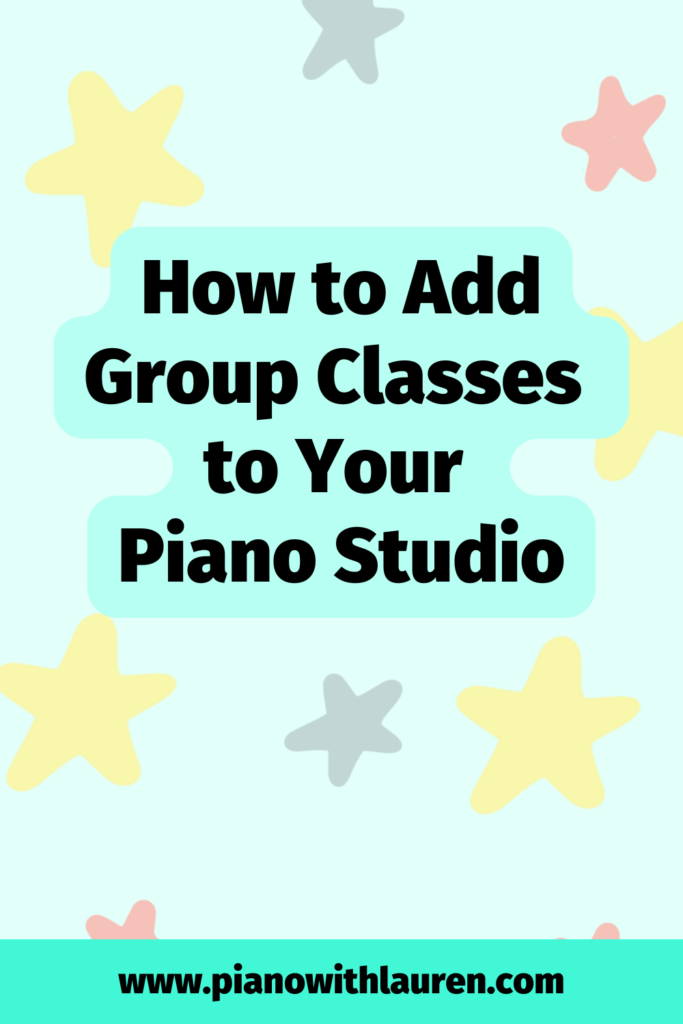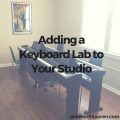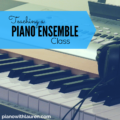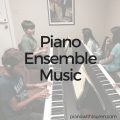This post may contain affiliate links. As a Sheet Music Plus and Amazon Associate, I earn from qualifying purchases. That means I make a small commission (at no additional cost to you) if you purchase something from an affiliate link.
Throughout my years of teaching, I have taught group piano classes in various scenarios. Group classes have many benefits both for student and teacher. Below are some options for adding group classes to your piano studio.

Option 1 – Group Only
Some large studio owners only teach group piano classes. For this, you would need a keyboard lab with several digital pianos. By only teaching group classes, studio owners are able to handle a larger volume of students. This could potentially mean larger profits. In my studio, I have offered sessions of group classes (such as 6-8 lessons) for beginners. Doing this over the summer is a great way for students to try lessons without the expense of private lessons.
Option 2 – Private & Group Class Weekly
When I first started teaching, I taught for a university preparatory music program. The program required that students participate in both a private and group class weekly. The group classes allowed students to work on keyboard skills, theory, and performance practice while the private lessons focused on repertoire. In this program, I found that my students excelled.
The logistics of offering both private and group lessons weekly can be a challenge for an independent music teacher. With a commitment for both, it is definitely possible though.
Option 3 – Private Lessons & One Monthly Group Class
Because I do not have the space or time to offer weekly group classes, I started adding monthly group classes to my studio many years ago. I have tried different things with the monthly group classes. I have tried a two-hour group class on Saturdays where students played ensemble music and music games together. Last year, I experimented with having just a one-hour group class where students played for each other and did a game. Both settings worked well.
Doing these types of group classes can be an extra, optional fee for students, included in tuition, or serve as a makeup option.
Option 4 – Occasional/Seasonal Group Class
Instead of monthly group classes, occasional group classes around holidays are also an option. Parents who do not travel during holidays are happy to have something for their children to do when not in school. The seasonal group classes can have fun themes such as Halloween, Thanksgiving, Christmas, Winter, or Spring. For this, you do not necessarily need a keyboard lab. Games and theory topics can be reviewed without keyboards. You can even pick a new topic to study such as composers or world music.
Option 5 – Substitute Private Lessons for a Group Class
Some teachers schedule group performance classes the week before a recital or contest so that students have a chance to practice performing. Teachers who do this have the group classes instead of regularly scheduled lessons. This can benefit both the teacher and student. Teachers can consolidate their teaching the week before a busy performance weekend. Meanwhile, students will benefit from playing for others.
Do you need a keyboard lab for group classes?
For many group class settings, you do not need a keyboard lab. Performance classes can be done with just your usual teaching piano. Gather students around the piano in chairs or have them sit on the floor.
If using ensemble music, you can use your teaching piano plus 1-2 added keyboards. Students can share the pianos or keyboards. I feel you do not need expensive keyboards to do this. In this setting, your focus would be playing together while developing rhythm and listening skills. Check out my ideas for keyboards on this post.
Think outside the box for offering group classes! Learning piano can be a solitary hobby, but it doesn’t have to be. Kids and teenagers really enjoy seeing other students who are learning piano.
Another Consideration
Another idea to consider with group classes is if students need to be grouped by similar ages. For classes where students are learning something new (such as an 8-week intro class), it helps if students are of similar ages so that the class moves at a similar pace.
For occasional group classes and performance classes, students can be of mixed ages. Check out this post for some activities to do with classes of mixed ages. I mention some ideas for a performance class in this post as well.
⭐️ If you have more questions about adding group classes to your studio, be sure to check out my consultations for teachers page.

Lauren teaches piano to students of all ages. She enjoys creating resources for her students and teachers. She is the author of Ready for Theory®. For personalized help, check out the consultations page for teachers.





We have been teaching in a group format since 2018 and have 180 students we see each week at the studio. I have 4 part time instructors and we teach 15 hours a week. It has worked incredibly well because we structured it correctly. It was a learning curve of how to do it right but our students are making way more progress than private lessons. We keep them for an hour and break it up between theory time and lesson book time. We also do a once a month 2 hour music enrichment class that the students love!
Thanks for the comment! I love how only group is working for your studio.